AEOLIS
|
11984. AEOLIS, KYME. Circa 155-143 BC. AR Tetradrachm (30mm, 16.46 g, 1h). Stephanophoric type. Euktemon, magistrate. Head of the Amazon Kyme right, wearing tainia / Horse prancing right; one-handled cup below, EYKTHMΩN in exergue; all within wreath. Oakley obv. die 57; SNG Copenhagen -; BMC 77 (same obv. die). Near EF, toned, some minor porosity. A portrait of exquisite sensual style of a highly voluptuous Greek nymph.
SOLD.
|
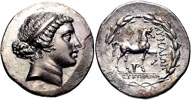
|
|
10785. AEOLIS, MYRINA, Circa 155-145 BC. AR Tetradrachm (34mm, 16.34 g, 12h). Stephanophoric type. Laureate head of Apollo right / Apollo Grynios standing right, holding branch and phiale; monogram to left, omphalos and amphora at feet; all within laurel wreath. Sacks Issue 19, obv. die 19; BMC 12. EF. Struck on an especially large medallic flan. The obverse one of the great masterpieces of Greek numismatic art.
SOLD.
|
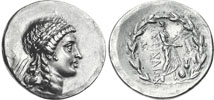 |
|
11030. AEOLIS, MYRINA, Circa 155-145 BC. AR Tetradrachm (33mm, 16.73 g, 12h). Laureate head of Apollo right / Apollo Grynios standing right, holding branch and phiale; monogram to left, omphalos and amphora at feet to right; all within laurel wreath. Sacks Issue 39 (obv. die 66) ; SNG Copenhagen -. EF. Struck on an especially large medallic flan. The obverse one of the great masterpieces of Greek numismatic art.
SOLD.
|
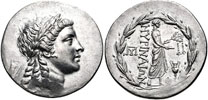 |
BITHYNIA
|
10143. BITHYNIA, KALCHEDON WITH PRIAPIC BULL, early 4th century BC. AR Drachm, GCV 3742. 350-300 BC, 3.77 gm, 15 mm. Bull standing on corn ear, caduceus before. /Quartered square incuse with raised dots. Good VF and nicely toned. A very rare coin, especially with the more classic square incuse dotted reverse! Nicer in hand than the photos show. A much more robust and impressive bull of better artistic quality than normal as e.g. found in the example above 8193, and the bull is priapic as well! Bithynia was the birthplace of Antinous and Theodosius.
|
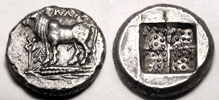 |
|
PERSEPHONE IN HADES
10367. BITHYNIA, NIKAIA. EXTREMELY RARE GREEK MEDALLION OF PERSEPHONE IN HADES, Asia Minor, c. 2nd century BC. Pb27, 12.52 g. Obverse: Hades seated three quarter facing on his throne in the underworld holding his scepter, the abducted Persephone standing to his right facing left; traces of an unknown legend around. Reverse: NIKAIΩN; Triptolemos naked driving a chariot pulled by two giant winged serpents left. Good F. Extremely rare, possibly unique. Remnants of gold plating. A wonderful depiction of one of the major Greek myths.
| 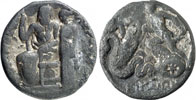 |
BITHYNIAN KINGDOM
NIKOMEDES I, c. 279-255 BC
ZIACLAS, c. 255-228 BC, (very few coins and only in bronze)
PRUSIAS I, c. 228-185 BC
|
12876. BITHYNIA, KINGS, PRUSIAS I CHLOROS. Circa 228-182 BC. AR Tetradrachm (35mm, 16.73 g, 12h). Nikomedeia(?) mint. Struck circa 210/200-182 BC. Diademed head right / Zeus Stratios standing left, holding scepter; to inner left, thunderbolt above two monograms. RG 9b; HGC 7, 614. VF, toned, wavy flan, test punch on obverse, light marks and scratches. Provenance: Ex Classical Numismatic Group Electronic Auction 291 (21 November 2012), lot 65.
|

|
PRUSIAS II, c. 185-149 BC
|
13030. BITHYNIA, KINGS, PRUSIAS II KYNEGOS. 182-149 BC. AR Tetradrachm (37mm, 16.68 g, 12h). Nikomedia mint. Head right with slight beard, wearing winged diadem / Zeus Stephanophoros standing left; to inner left, eagle standing left on thunderbolt above monogram. Kaye Series D, 40-1 (unlisted dies); RG 10; HGC 7, 623. VF, toned, short flan crack, light marks and scratches.
|

|
NIKOMEDES II, EPIPHANES, c. 149-128 BC
NIKOMEDES III, EUERGETES, c. 128-94 BC (portraits and epithets those of Nikomedes II)
|
PEDIGREED AND PUBLISHED
11281. BITHYNIA, KINGS, NIKOMEDES III EPIPHANES. 149-120 BC. AR Tetradrachm (34mm, 15.73 g, 12h). Dated 198 BE (100/99 BC). Diademed head and epithet of Nikomedes II right / Zeus Stephanophoros standing left; to inner left, eagle standing left on thunderbolt above monogram and H(koppa)P monogram (date). Callatay p. 54, dies D115/R1, a = Davis Collection 193 (this coin); SNG Copenhagen –; SNG von Aulock –; McClean 7544 var. (monogram); DCA 444. Near EF, attractively toned, minor die wear on obverse. Rare date. Considerably better style portrait than usual. Provenance: From the Deyo Collection. Ex CNG 90, Lot 570; Numismatic Fine Arts Fall Mail Bid Sale (12 October 1985), lot 286; Norman Davis Collection (Numismatic Fine Arts XI, 8 December 1982), lot 152.
SOLD.
|
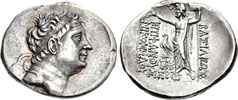
|
NIKOMEDES IV, PHILOPATOR, c. 94-74 BC (also used portrait and epithet of Nikomedes II)
CAPPADOCIAN KINGDOM
OROPHERNES, 158-157 BC
ARIARATHES V, EUSEBES, c 163-130 BC
|
11518. CAPPADOCIAN KINGDOM: ARIARATHES V EUSEBES (ca. 163-130 BC). AR tetradrachm (16.21 gm). Struck ca. 133 BC. Diademed head of Ariarathes V right / BAΣIΛEΩΣ APIAPAΘOY EYΣEBoYΣ on three sides, helmeted Athena standing half-left, holding Nike bearing crown and resting hand on grounded shield decorated with Gorgoneion, spear resting in crook of arm, monograms in outer left, inner left, and outer right fields, date Λ (regnal year 30) in exergue. Simonetta p. 23, 2 (Ariarathes IV). Very rare. Small flan flaw in upper right field. Dark tone. Nearly extremely fine.
SOLD.
|
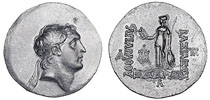 |
ARIARATHES IX, EUSEBES PHILOPATOR, 158-157 BC
CARIA
|
6073. CARIA, KNIDOS, 390-330 BC. AR Tetradrachm, Sear 4839 (£2500). Hd. Aphrodite l./Forepart lion l. EF. Natural toning. Rare.
|
 |
|
8568. CARIA, KINDYA. Circa 510-480 BC. AR Tetrobol (10mm, 1.99 g). Head of Ketos left / Geometric pattern within incuse square. Kagan & Kritt 1; SNG Keckman 920; SNG von Aulock 2340; SNG Kayhan 810; Asyut 687; Rosen 617. Good VF, toned. One of the finest examples known.
SOLD.
|
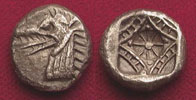 |
|
6074. CARIAN SATRAPS, MAUSALOS, 365-351 BC. AR Tetradrachm (14.8 gm), 21.5 mm. Facing hd. Apollo/Zeus Labraundos, holding double-headed axe. Choice VF with muted gray toning and appealing style. The Apollo hd. rendered with exceptional expression.
|
 |
|
6526. Greek Satraps of Caria, Hidreaus (351-344 BC). Ar Tetradrachm (15.12 gm). Obverse laureate head of Apollo, facing slightly to the right. Reverse Zeus Labraundos, holding double-headed axe, M to left, inscription IDPIEWS. S4958. Toned EF, of exceptional style.
SOLD.
|
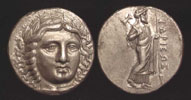 |
|
10476. CARIA, KAUNOS, Circa 410-390 BC. AR Stater (19mm, 11.45 g, 9h). Winged female figure of the goddess Iris in kneeling-running stance left, head right, holding kerykeion and wreath / Baetyl(?) between &Delta (inverted) and Γ; all within incuse square. Konuk 101 (O42/R42); SNG Copenhagen -. VF. From the R.D. Frederick Collection.
|  |
|
10477. CARIA, MYLASA, Circa 520-490 BC. AR Stater (20mm, 10.82 g). Forepart of a roaring lion right / Divided incuse punch. SNG Kayhan 930 (Uncertain); SNG Keckman 64 var. (lion left); ACGC 993. VF, rough find patina. Rare. Ex CNG. From the N.T. Collection. Ex Classical Numismatic Group 55 (13 September 2000), lot 572. |
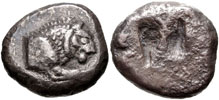 |
|
8561. CARIA, MYNDOS, 2nd-1st century BC. AR Drachm, BMC.6, Sear 4915. Laureate head of Zeus r. wearing head-dress of Osiris/Head-dress of Isis., thunderbolt beneath. EF. Choice example of this extremely interesting coin which reflects the spread of the cult of Isis through the Mediterranean in Hellenistic times. Even the cobra on the head-dress of Isis is visible which it is not in the Sear plate coin.
SOLD.
|
 |
|
10746. CARIA, RHODES, ISLANDS off CARIA, Rhodos. Circa 188-170 BC. AR Drachm (17mm, 2.60 g, 12h). ‘Plinthophoric’ coinage. Artemon, magistrate. Radiate head of Helios right / Rose with bud to right; ARTEMĹN above, crown of Isis to lower left; all within incuse square. Jenkins, Rhodian, Group A, 20; SNG Keckman -; cf. SNG Copenhagen 813 (symbol); HGC 6, 1457. EF. A choice sharp perfectly centered example. See a lesser example of the same magistrate which sold for $3500 at Ponterio & Associates sale #148 NYINC Auction, lot 369.
The Sun God Helios, was worshipped locally. The famous Colossus of Rhodes, one of the Seven Wonders of the Ancient World was a statue of Helios.
|
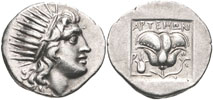 |
|
10200. LARGE AE37 OF CARIA, RHODES, after 164 BC. AE 37mm, Weight: 22.88 gm. Similar to Sear #5083. It was struck as a local coinage during the Roman Period, after 164 BC on Rhodes. It probably served for the equivalent denomination as a Roman Sestertius.
Head of the sun god Helios right. / Nike walking right. The Sun God Helios, was worshipped locally. The famous Colossus of Rhodes, one of the Seven Wonders of the Ancient World was a statue of Helios. VF. High profile head of Helios.
|
 |
|
PEDIGREED AND PUBLISHED
10737. RHODIAN LARGE BRONZE. CARIA, RHODES, circa 31 BC-60 AD. AE 33mm (22.55 g). Teimostratos, magistrate. Radiate head of young Dionysos right, wearing ivy wreath / Rose with two buds between poppy and stalk of grain. RPC I 2748.4 (this coin listed); Lindgren 700 (this coin); SNG Copenhagen 888. Near VF, brown patina. Scarce. The Sun God Helios, was worshipped locally. The famous Colossus of Rhodes, one of the Seven Wonders of the Ancient World was a statue of Helios.
|
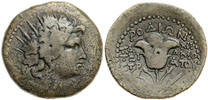 |
|
11050. CARIA, RHODES, ISLANDS off CARIA, Rhodos. Pseudo-autonomous issue. Time of Nero, AD 54-68. AE Drachm (34mm, 25.45 g, 12h). Epikrates, magistrate. Radiate head of Dionysos left, wreathed with ivy. / Nike standing left on rose, holding aphlaston and palm. RPC I 2762; SNG von Aulock 2849. VF, mottled brown patina, very minor pitting. Attractive example better than most.
|
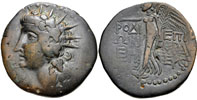 |
|
10172. CARIA, RHODES, KAMIROS, Circa 500-480 BC. AR Stater (11.91 gm, 17x20 mm). Fig leaf / Rectangular incuse divided by thick central band. Asyut 699; BMC Caria pg. 223, 3; SNG Copenhagen 712; SNG von Aulock 2779; Dewing 2396 . VF, toned. Excellent metal for issue. A rare archaic Greek issue. |
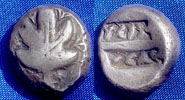 |
CILICIA
|
8917. CILICIA, AIGEAI, 3rd century BC. AR Tetradrachm, 27 mm, 14.61 g. Sear_, SNG Copenhagen_, Van Aulock_. Turreted hd Tyche r./Minerva stg l. EF. An exceptionally rare coin. Until a recent small group was found only 8 were known. Missing from most major collections.
|
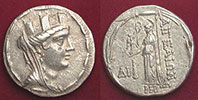
|
|
11000. CILICIA, HIEROPOLIS-KASTABALA, Pseudo-autonomous issue. Circa 1st century AD. AE Medallion (31mm, 21.45 g, 11h). Bust of Athena left, wearing crested helmet and aegis / Bust of Hygeia left; coiled serpent before. SNG France -; SNG Levante 1576 (same dies). Fine, green and brown patina, some light smoothing and tooling. Very rare.
|
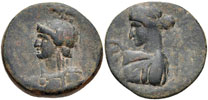
|
|
11129. CILICIA, KELENDARIS, Circa 410-375 BC. AR Stater (20mm, 10.73 g, 9h). Nude youth, holding whip, dismounting from horse rearing right / Goat kneeling right, head left; in exergue, dolphin right. Casabonne type 4; SNG France -; SNG Levante 23. Near VF. Lustrous. Especially sharp reverse.
| 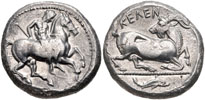 |
|
6078. CILICIA, MALLOS, 420-375 BC. AR Stater, 24 mm, 9.98 g. Sear 5559v. Winged male figure in kneeling-running position holding disk with both hands/Swan stg. r. AVF. Rare. Considerably better than photo.
|
 |
|
6079. CILICIA, NAGIDOS, 420-390 BC. AR Stater, Sear 5578 (£650). Aphrodite enthroned l., Eros at her side/Dionysos, naked but for chlamys stg. l. EF. Better than usual detail and usual small flan. Rare early type for Nagidos.
|
 |
|
12939. CILICIA, TARSOS, MAZALOS. Satrap of Cilicia, 361/0-334 BC. AR Stater (23mm, 10.88 g, 12h). Baaltars seated left, head and torso facing, holding eagle, grain ear, and grape bunch in extended right hand, lotus-tipped scepter in left; TN (in Aramaic) to left, M (in Aramaic) below throne, B’LTRZ (in Aramaic) to right / Lion attacking bull left; MZDY (in Aramaic) above, monogram below. Casabonne Series 2, Group C; SNG France –; SNG Levante 106. EF, lightly toned, a little off center. Provenance: From the collection of a Southern Pathologist, purchased from Rob Golan, 29 October 1994.
SOLD.
|
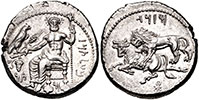 |
|
6080. CILICIA, TARSOS, PHARNABAZOS, 379-374 BC. AR Stater, Sear 5640v. Female hd. 3/4 face to l./Helmeted male hd. r. EF.
|
 |
|
9392. CILICIA, TARSOS, DATAMES SATRAP, 378-362 BC. AR Stater, Copenhagen 295, Sear 5645. Baal of Tarsos enthroned r. holding eagle-tipped scepter and corn-ear with bunch of grapes, thymiateriaon at his side, behind Aramaic legend, beneath throne, flower, all within a border representing battlements of the city/Satrap enthroned r. sighting arrow, quiver on his lap, in field above, winged solar disk. EF. Rare.
|
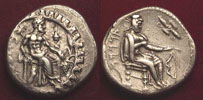
|
|
10993. CILICIA, TARSOS, MAZALOS Satrap of Cilicia, 361/0-334 BC. AR Stater (23mm, 11.34 g, 9h). Baaltars enthroned left, holding grain ear, grape bunch and scepter; monogram below throne / Lion attacking stag to the left; O below. SNG France 318. Near VF, light marks under toned, test cut.  $1250. $1250.
|
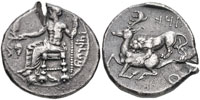 |
|
8049. CILICIA, TARSOS, AR Stater, c. 327 BC. Sear 5651v, Copenhagen 322. Baal of Tarsos, enthroned l./Lion bringing down bull abv. two rows of fortified city walls, Club and B at top. Flatness on lionís face. VF. Scarce variant with club and B rather than the usual Aramaic inscription.
|
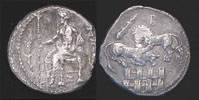 |
|
10357. CILICIA, TARSOS, AR obol? 0.68g. 9mm. Obverse: Female head right. Reverse: Squatting bare breasted girl holding the lowered top of her gown over her left arm while she plays with 4 balls or astralagoi with her right. VF, some surface roughness. An exceptional depiction of great beauty in a very tiny space. Rare. SNG Levante plate 4, 65.
|

|
|
8563. CILICIA, UNCERTAIN MINT, PERHAPS TARSOS, 4th century BC. AR 3/4 Obol, Sear 5663; SNG Levante 229; SNG BN 472. Facing head of young Herakles/Eagle perched on stag's head between its large antlers. EF. While the obverse of this issue is rather crudely done, the reverse remains quite an interesting type. Rare this nice. |
 |
IONIA
|
10726. ISLANDS off IONIA. CHIOS. Circa 380-350 BC. AR Drachm (12mm, 3.60 g). Sphinx seated left; to left, grape bunch above amphora; K to right / Quadripartite incuse square. Baldwin, Chios 84; SNG Copenhagen 1546. VF, toned. From the MIT Collection. Ex Superior (3 December 1999), lot 1496. Scarce archaic issue. A pleasing example with both the entire obverse and reverse perfectly centered and on the flan. A classic example of fine Greek art.
| 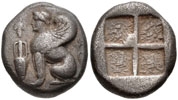 |
|
10879. IONIA, EPHESOS, Circa 390-325 BC. AR Tetradrachm (23mm, 15.24 g, 12h). Phurtas, magistrate. Struck circa 370-360 BC. Bee with straight wings; E-Φ across / Forepart of stag right; palm tree to left, ΦYPTAΣ to right. Pixodarus class E, obv. die 60; SNG Kayhan -; SNG von Aulock -; SNG Copenhagen -; BMC -; SNG München -; Giessener Münzhandlung 84, lot 5309. VF, toned, some obverse die wear.
$1450.
| 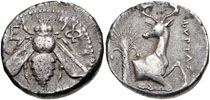 |
|
8564. IONIA, EPHESOS, 48-27 BC. AE19, Sear 4414. Bust Artemis r./Two stags, torch between. VF. Scarce example with a wonderfully intense, almost frenzied, face of Artemis. |
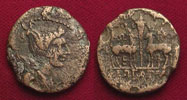 |
|
8565. IONIA, HERAKLEIA, 2nd century BC. AR tetradrachm, Sear 4453. Head of Athena r./Club with small owl below. Choice EF. Superb sharp example with Athena's helmet ornamented with Pegasus and foreparts of five horses. Considerably better than photo.
SOLD. |
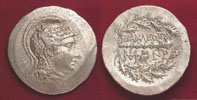 |
|
12946. IONIA, MAGNESIA AD MAEANDRUM. Circa 150-140 BC. AR Tetradrachm (32mm, 16.83 g, 12h). Stephanophoric type. Euphemos, son of Pausanios, "magistrate". Diademed and draped bust of Artemis right, bow and quiver over shoulder / Apollo Delphios standing left, resting on tall tripod to right, holding branch tied with fillet; EYΦHMOΣ ΠAYΣANIOY in two lines to left, meander pattern below; all within laurel wreath. Jones pp. 102-4 (unlisted obv. die); Waddington 1725 (same obv. die). Good VF, toned. Provenance: Ex Seaby Coin & Medal Bulletin 736 (December 1979), no. C1300.
SOLD.
|
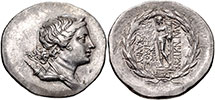 |
|
7537. CHOICE EARLY ELECTRUM STATER OF MILETOS, 600-550 BC.
The first true coins seem to have been minted in Asia Minor in the late 7th or early 6th century BC. These coins were struck in electrum, a naturally occurring alloy of gold and silver found in the Pactolus and other nearby rivers. Several Greek cities including Miletos on the Western coast as well as the Lydian kings began minting these first coins by stamping the badge of their city into one side of a standard weight lump of electrum and various punches into the other. These devices were used to facilitate trade by certifying that the intrinsic value and weight of the metal was guaranteed by the issuing authority. Of these first coins, those of Miletos like the current example, are probably the finest from an artistic perspective. The lion, cleverly configured with its head reverted and tail curled over its haunch to neatly fit within the rectangular frame, is a masterpiece of Archaic Greek art. The vigor and ferocity of the beast are beautifully conveyed by its snarling countenance and erect mane.
The current piece is an excellent example of these extremely rare coins. Most of the few surviving examples are in poor condition or with irregular lumpy flans. This is without doubt a piece worthy of the finest collection. Obverse: Lion lying left, looking back and roaring, all within a double rectangular frame divided into segments. Reverse: Three incuse punches; an oblong punch containing a fox between two square punches, one containing the head of a stag, the other a star shaped ornament. Mean Diameter: 21 x 17.5 mm. (0.827 x 0.689"). Weight: 13.91 gm. (0.435 Troy oz.). Metal composition: Gold with some silver content. References: David Sear, Greek Coins, Vol. 2, # 3439. Grade: AEF.
SOLD.
|
 |
|
11865. IONIA, SMYRNA. Circa 150-143 BC. AR Tetradrachm (35mm, 16.38 g, 12h). Stephanophoric type. Poseidonios, magistrate. Turreted head of Tyche right / Ethnic and monogram within laurel wreath. Milne, Silver 2, obv. die B; SNG Copenhagen -; SNG von Aulock 2161. EF, toned, porous in areas, minor flan flaw on cheek.
SOLD.
|
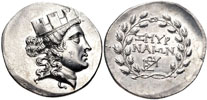
|
|
THE POET HOMER
11301. IONIA, SMYRNA. Circa 75-50 BC. AE (23mm, 13.24 g, 1h). Athenagoras Gorymb-, magistrate. Laureate head of Apollo right / The poet Homer seated left, holding scroll; star left. Milne, Autonomous 388. Good VF, green patina. Splendid well centered depiction of the famous Greek poet and author of the Iliad on a coin of the city where he was said to have been born. The figure of Homer one in a hundred as almost all are either off the flan or worn.
|
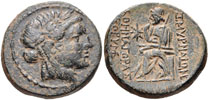
|
|
11303. IONIA, SMYRNA. Pseudo-autonomous issue. temp. Antoninus Pius - Marcus Aurelius, circa AD 160-180. AE (22mm, 8.39 g, 1h). Bare head of Zeus Akraios right / Artemis Panionios standing left, holding laurel branch and bow and arrow; prow at feet to left. Klose Type VI, series A, - (V3/R5 - unlisted die combination); BMC 157 (same obv. die). EF, black patina. From artistic dies and in far superior condition than the specimens illustrated in Klose's die study. A magnificent and noble head of Zeus of the finest classical style.
|
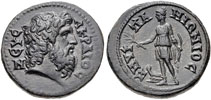
|
|
10420. IONIA, TEOS. C. 510-490 B.C. AR stater. Obverse: Griffin sitting right raising a front leg; in front of him, a bunch of grapes on its branch. Reverse: Quadripartite hollow square. Choice EF. AR 19.0 mm, 11.93 g, 1:00. SNG Lockett 2851, Balcer 15, Jameson 1516. Well centered on a circular flan for this specimen of very beautiful quality, presenting a nice style and with a fine gray patina. Rare.
|  |
LESBOS
|
11007. LESBOS, UNCERTAIN early mint. Circa 500-450 BC. BI Stater (18mm, 11.04 g). Confronted bull calves heads; olive tree behind. / Small incuse square punch. SNG Copenhagen 285; SNG von Aulock 1682; Rosen 540. Good VF, darkly toned. A superior example perfectly centered on a wonderful round flan.
|
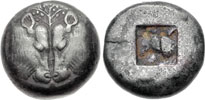
|
|
9400. LESBOS, METHYMNA, AR Obol, 0.65 gm. Hd. Athena wearing Attic helmet r./Turtle in incuse square with pearls. VF. Excessively rare. See another only slightly better example listed on VCoins by Dr. Martina Dieterle at $2188 as of 8/10. There is also one other occurrence in an old M&M catalog where it is listed as uncertain Asia Minor.
|
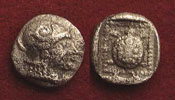
|
|
THE POETESS SAPPHO
8916. EXTREMELY RARE PORTRAIT OF SAPPHO, LESBOS, MYTILENE, ca. 350-250 BC. AE14, BMC 37ff, SNG Copenhagen 383, Von Aulock_. Head of Sappho r. wearing sphendone/Lyre. AVF. Extremely rare representation of the most famous poetess of Ancient Greece on a coin of the city where she lived. Not many known and they rarely come much better.
|
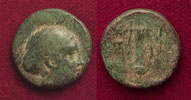
|
|
8570. LESBOS, MYTILENE, ca. 1st-2nd century. AE40 Medallion. Torso of Asclepius l. of fine Classical style/Asclepius std. l. resting left arm on long staff and reaching toward serpent with right. AVF. Holed & flan chip. Extremely rare. |
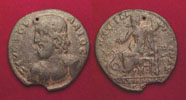 |
LYCIA
|
6531. LYCIA. AR Stater. Forepart boar r./ Incuse punch of triangular forms. VF+. Test cut on edge.
| 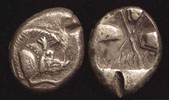 |
|
10992. LYCIA. DYNASTS of LYCIA. Uncertain dynast. Circa 490/80-440/30 BC. AR Stater (23mm, 9.41 g, 2h). Pegasos flying left / Opposed foreparts of bull and lion with extended leg; Lycian letter T below; all within beaded border and incuse square. Falghera 62; SNG Copenhagen Supp. -. Good Fine, broad irregular flan, test cut on reverse.
| 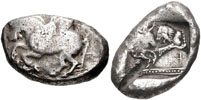 |
|
10406. LYCIA. AR Stater. Uncertain dynast 480-440 BC. AR stater : Pegasus left with pellet on raised circular shield with border. / Triskeles in incuse circle. 9.6 grams. VF. Rare.
| 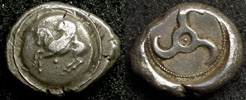 |
LYDIA
|
THE MOST VISUALLY APPEALING EXAMPLE I'VE SEEN
12938. LYDIA, KINGS, time of ALYATTES - KROISOS. Circa 620/10-550/39 BC. EL Trite = Third Stater (12.5mm, 4.77 g). Sardes mint. Head of roaring lion right, sun with multiple rays visible over forehead / Two incuse square punches. Weidauer Group XVI, 86-9; Traite I 44; SNG Kayhan 1013; SNG von Aulock 2868-9. Near EF. A truly exceptional example. In terms of clarity, strike, artistic style, and centering with everything visible on an aesthetically symmetrical flan, this is the finest example I've seen.
SOLD.
|
 |
|
10478. LYDIA, KINGS, KROISOS, 560-546 BC. Circa 560-546 BC. AR Double Siglos = Stater (19mm, 10.55 g). Sardes mint. Struck circa 550-546 BC. Confronted foreparts of lion and bull / Two incuse square punches of unequal size. Berk 120/20; SNG Kayhan 1018. VF, toned, some porosity. From the N.T. Collection. Ex CNG. Rare, not the more usual half stater. A fine example of the largest type of the first silver coins ever struck. Prior to Kroisos' issuance of a bimetallic gold and silver currency, all earlier coins had been struck of electrum, a naturally occurring alloy of gold and silver. Very nice example of this historic coin with old cabinet toning. |
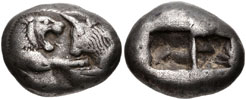 |
MYSIA
|
FIRST NUMISMATIC PORTRAIT OF A LIVING PERSON?
10990. FIRST PORTRAIT OF A LIVING PERSON ON A COIN? MYSIA, ASTYRA, TISSAPHERNES. Circa 400-395 BC. AE (11mm, 21.50 g, 2h). Bare head right / Cult statue of Artemis Astyra. SNG France 124A. Near VF, dark green patina. Scarce portrait of Tissaphernes, a ruler of great historical significance in both Greek and Persian history. Important and historical because this type is possibly the first portrayal of a living man on a coin. Tissaphernes was Satrap of Lydia and Karia c. 415 - 404 B.C. and of Lydia c. 400 - 395 B.C. |
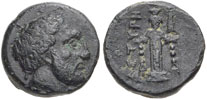 |
|
FIRST NUMISMATIC PORTRAIT OF A LIVING PERSON?
11326. FIRST PORTRAIT OF A LIVING PERSON ON A COIN? MYSIA, ASTYRA, TISSAPHERNES. Circa 400-395 BC. AE (12mm, 1.63 g, 12h). Bare head right / Cult statue of Artemis Astyrene; club to right. Winzer 6.2; SNG France 124A; Klein 253. Near EF, glossy black patina. Scarce and especially bold portrait of Tissaphernes, a ruler of great historical significance in both Greek and Persian history. Important and historical because this type is possibly the first portrayal of a living man on a coin. Tissaphernes was Satrap of Lydia and Karia c. 415 - 404 B.C. and of Lydia c. 400 - 395 B.C. |
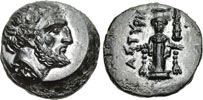 |
|
8572. MYSIA, IOLLAS, ca. 400-300 BC. AE20, Sear 3874. Head Athena wearing crested helmet r./Forepart of Pegasos r. with curled wings and wing at termination. EF. Very rare. Superb example, likely one of the finest known, with an excellent patina. |
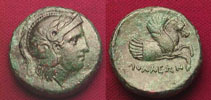 |
|
7538. MYSIA, KYZIKOS, ca. 550 BC, Electrum Stater, Rosen443.
Winged Boar, tunny fish below/Four part incuse. AVF. Very RARE!
|
 |
|
10991. MYSIA, KYZIKOS, Circa 390-341/0 BC. AR Tetradrachm (23mm, 14.85 g, 3h). Wreathed head of Kore Soteira left, hair in sphendone covered with veil / Head of lion left; below, tunny fish left; pilos to right. Von Fritze II, 23; Pixodarus Type 2, -; SNG France -. Fine, toned, porosity, test cut on reverse not affecting the figures. An issue with very fine Greek numismatic art especially the head of Kore.
|
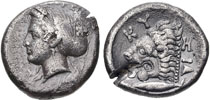
|
|
10481. MYSIA, PARION. 4th century BC. AR Hemidrachm (13mm, 2.35 g, 12h). Bull standing left, head right; pilos above / Gorgoneion. SNG France 1371. Good VF, toned. From the R.D. Frederick Collection.
|  |
KINGDOM OF PERGAMON
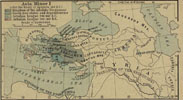
The tetradrachms of the subsequent Pergamene kings all retain the likeness and name of Philetairos, the first king of Pergamon.
|
8580. PERGAMON, KINGS, ATTALOS I, 241-197 BC. AR Tetradrachm, BMC.35, Sear 7220. Hd Philetaros r. wearing laurel wreath/Athena std. l., bow behind, ivy leaf and monogram before. EF+. Superb sharp very high profile example with incredible detail and of the finest style. Tiny ding at bottom edge and a few light scratches which don't detract only mentioned to complete the description of condition. The finest example I've seen and worthy of the finest collection.
All of the tetradrachms of the Pergamene kings feature a portrait of Philetaros the first of the line. |
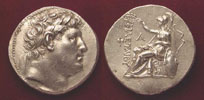 |
|
10580. MYSIA, PERGAMON, c. 100 BC. AE16, 3.30 g. Sear 3871. Head of Asklepios right. Reverse: Snake climbing the staff of Asklepios. Near VF. A classic Asklepian healing coin. |
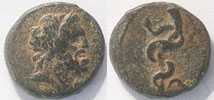 |
PAMPHYLIA
|
10430. PAMPHYLIA, PERGE. Circa 170-100 BC. AR Tetradrachm (28mm, 15.82 g, 12h). Wreathed head of Artemis right, bow and quiver over shoulder / Artemis standing left, holding wreath and scepter; at side, stag standing left, head right. Colin Series 2, Em. 10 (dies 5.2/15.4); SNG France 326-7. VF, toned, porous.
| 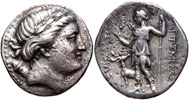 |
|
11128. PAMPHYLIA, SIDE. Circa 360-333 BC. AR Stater (19mm, 10.52 g, 12h). Athena standing left, holding Nike, shield, and spear; pomegranate to left, letters to right / Apollo, wearing chiton, standing left, quiver over shoulder, holding patera and scepter; altar to left. Atlan 159 (Ö123/A150); SNG France - (but same obv. die as 657-8). Good Fine/ VF, toned, porous. An especially impressive classic styled reverse scene.
| 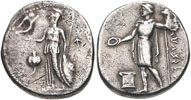 |
|
10501. PAMPHYLIA, SIDE. Circa 205-100 BC. AR Tetradrachm (32mm, 16.72 g, 12h). DEIN(O)-, magistrate. Head of Athena right, wearing crested Corinthian helmet / Nike advancing left, holding wreath; pomegranate in left field, ΔEI-N across field. Seyrig, Side 7; SNG France 677 var. (ΔEI-NO); SNG von Aulock 4787 var. (same). Good VF, lightly toned.
| 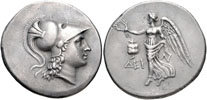 |
PAPHLAGONIA
|
11006. PAPHLAGONIA, KROMNA. 4th century BC. AR Drachm (16mm, 3.53 g, 11h). Laureate head of Zeus left / Head of Hera left, wearing ornate stephane, crescent above; monogram below chin. RG 2 var. (monogram); SNG BM Black Sea 1343 var. (same obv. die, different control mark); SNG Copenhagen 262 var. (monogram); SNG von Aulock 183-7 var. (same). Near EF, toned. Fine style, a masterpiece of Greek numismatic art. See one in nearly identical condition that went for $12,590, LHS Numismatik Auction 102 (29.04.2008) lot 252. The style of the Zeus in our example of even finer artistic quality.
SOLD.
|
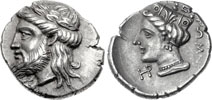 |
KINGDOM OF PAPHLAGONIA
|
11300. PAPHLAGONIA, KINGS, PYLAIMENES EUERGETES (Pylaemenes), Circa 133-103 BC. (21mm, 6.87g). .
Bust of Pylaimenes as Herakles right, club over shoulder, lion's skin around neck / Nike standing left, holding wreath and palm. SNG BM Black Sea 1550. SNG Copenhagen 321. SNG Stancomb -. SNG von Aulock 148. EF. A choice example of this rare king's coinage bearing a wonderful portrait of him as Herakles, apparently one of the finest known.
Occupying the northern bulge of what is modern Turkey on the Black Sea, the Paphlagonians were an ancient people whose mythical founder Pylaimenes of the Eneti tribe appears in the Odyssey as an ally of Troy where he is slain by Menelaus. All the later kings of Paphlagonia also carried the same name. The famous Cynic philosopher Diogenes of Sinope was also from Paphlagonia. |
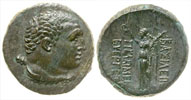 |
|
11367. PAPHLAGONIA, KINGS, UNCERTAIN KING, Sinope, c. 120-100 BC, AE, (g 21,14, mm 26, h 12). Male head r., wearing leather cap, Rv. ΣIN-ΩΠHΣ, quiver. SNG BM Black Sea n. 1523. Very rare. Dark patina. Minor breaks of die. Good extremely fine. EF. A choice example of this rare king's coinage bearing a wonderful portrait of him dressed in the local head dress, apparently one of the finest known.
Occupying the northern bulge of what is modern Turkey on the Black Sea, the Paphlagonians were an ancient people whose mythical founder Pylaimenes of the Eneti tribe appears in the Odyssey as an ally of Troy where he is slain by Menelaus. All the later kings of Paphlagonia also carried the same name. The famous Cynic philosopher Diogenes of Sinope was also from Paphlagonia. |
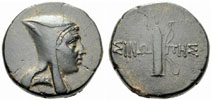 |
PHRYGIA
PISIDIA
|
8579. PISIDIA, SELGE, ca. 370-360 BC. AR Stater, SNG Cop.249, Sear GCV 5471. Two nude wrestlers grappling. / Slinger wearing short tunic preparing to throw, triskeles before, ΣTΛEΛIIYΣ to left, all within beaded square. Icard, DICTIONARY OF GREEK COIN INSCRIPTIONS, lists this inscription for Selge Pisidiae. It is listed as ESTLELIIYS (Latin transliteration). This coin is missing the E at the beginning, but Head in Historia Numorum (page 711) says that the inscription without the E is one of the variations used at Selge. It is most likely the name of the city in the local Pisidian form, rather than the name of a magistrate. EF. Scarce, not the more usual similar type from Aspendos in Pamphylia. A wonderful example of the ability of Greek numismatic art to convey lively action. A fine example of the type with excellent style and detail.
$3750. |
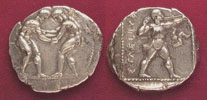 |
PONTOS
|
7721. PONTOS, AMISOS, Late 2nd-1st century BC. AE31. Hd Athena/Perseus holding harpa and hd of Medusa. VF+. Excellent example of this sought after mythological type depicting the killing of Medusa by the hero Perseus.
|
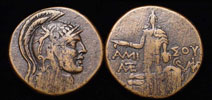 |
|
10759. PONTOS, AMISOS, Circa 100-85 BC. AE 20-21mm. Helmeted head of youthful Ares / Sword in sheath. Σ-A across reverse field. SNG BM Black Sea 1150. Near EF. Choice example.
|
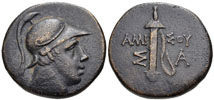 |
THE PONTIC KINGDOM
MITHRADATES II, c. 255-220 BC
MITHRADATES III, c. 220-185 BC
MITHRADATES IV, c. 159-150 BC
MITHRADATES VI, EUPATOR, Mithradates the Great, c. 120-63 BC
|
CHOICE EF EXAMPLE
10474. PONTOS, KINGS, MITHRADATES VI, 120-63 B.C. Gold stater (in the name of Lysimachos), time of the 1st Mithradatic War, 88-86 B.C. Head of deified Alexander the Great wearing horn of Ammon right. Rv. BASILEWS LYSIMAXOY; Athena enthroned l., Δ to inner left below her outstretched arm, &Sigma below and trident in ex. De Callatay, p.141v, SNG Cop. 1091v, AMNG 2480v. EF. Choice example much superior to almost all on the market.
SOLD. |
 |
|
11135. PONTOS, KINGS, MITHRADATES VI, Thrace, Odessos mint. Circa 80-72/1 BC. AR Tetradrachm (30mm, 16.35 g, 1h). In the name and types of Alexander III of Macedon. Head of Herakles right with the features of Mithradates, wearing lion skin / Zeus Aetophoros seated left; ΛAKΩ in left field, OΔH in exergue. Callatay Group 3 (D4/R?); Price 1193. Good VF, lightly toned. Choice style portrait of this historically important and powerful king. |
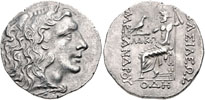 |
|
12957. PONTOS, KINGS, POLEMO II (Polemon II) with TRYPHANAE, Circa AD 38-64. AR Drachm (17.5mm, 3.27 g, 7h). Struck circa 50s AD. Diademed head of Polemo right / Diademed head of Tryphanae right. Cf. RG 27-8; RPC I 3811. Fine, toned, rough surfaces, harshly cleaned. Rare. |
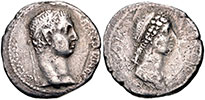 |
TROAS
|
VERY RARE COIN FROM TROY
12943. TROAS, ILION (the Greek name of Troy after which Homer's Iliad was named), 188-133 BC. Silver Tetradrachm (39mm, 16.95 gm.) Reference: BMC -; A. R. Bellinger, The First Civic Tetradrachms of Ilium, ANSMN VIII (1958) -; SNG Aul. ; Bellinger, Troy; SNG Cop. Munsterberg; Davis 202. Head of Athena wearing Attic helmet right. Athena Ilias standing right, holding distaff and filleted spear; at her feet, owl standing to right, winged caduceus to left; across field AΘHNAΣ IΛIAΔOΣ, AKKOY in exergue. EF. Choice example with a huge flan. A beautiful and very rare coin from the city of the Trojan war. Provenance: Gorny and Mosch, Auction 224, 10/13/2014 lot 229.
| 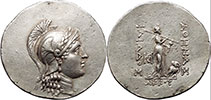 |
|
10290. TROAS, GERGIS, 400-350 BC, bronze of 16.5 mm, 3.30 grams.
Obverse: Facing head of the Sibyl Heophile. Reverse: Sphinx. Reference: Grose 7824. Interesting coin in nice quality! Scarce. This lot is accompanied by a photo-authenticity receipt signed by David Hendin, author of Guide to Biblical Coins.
| 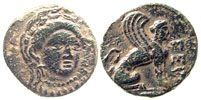 |
|
6083. TROAS, TENEDOS, c. 400 BC. AR Tetradrachm, Sear 4152. Janiform hds. of bearded Zeus l. and Hera r./TENEDION above and both sides of double axe, grape bunch to l., lyre to r., all within incuse square. VF. Very Rare. Normal surface wear but face of Hera much clearer than Sear example.
|
 |
UNCERTAIN MINT
|
APPARENTLY UNIQUE MEDALLION OF KORE
8192. UNCERTAIN MINT, LIKELY KYZIKOS, Asia Minor, c. 2nd century BC/AD. AE19 uniface medallion honoring the Goddess Kore. Obverse: ΚΟΡΗ, bust of the goddess r./Reverse: Blank. The likely attribution of this piece to Kyzikos due to the fact that the only coins with KORH and this obverse image were struck there. Coins from other mints honoring this goddess normally carry the legend KORH SWTEIRA or similar. There are 5 known types all with this obverse and 19 mm. from Kyzikos.
1) Rev: KYZIKHNWN NEW, Demeter walking right, holding two torches. SNG Tuebingen 2276; Fritze Nomisma X, 47.
2) Rev: KYZIKHNW NEOKO (or NEWKO) Coiled serpent, SNG Stockholm 2029; Fritze Nomisma X, 49.
3) Rev: KYZIKHNW NEO, serpent on altar. BMC 202.
4) Rev: KYZIKHNW NEO, Eagle standing front, head left. SNG von Aulock 1258; Fritze Nomisma X 43B
5) Rev: KYZIKHNW NEO, ostrich right. Weber 5053; Imhoof GM 167A; ; Fritze Nomisma X 46A
VF. Extremely rare, likely unique. Choice glossy forest green patina.
| 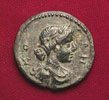 |
|
10493. ASIA MINOR?, UNATTRIBUTED, Female head left. / Possibly Isis seated left holding crown of Isis, or more likely Demeter seated left holding large corn ear. AE 18 mm. Reference appreciated. Similar seated Demeters holding corn ears appear on the coins of Nicaea, Bithynia but these seem to all be Roman provincial coins with heads of emperors on the obverse. So this could possibly be an earlier issue of Nicaea.
|
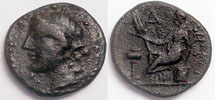
|













































































